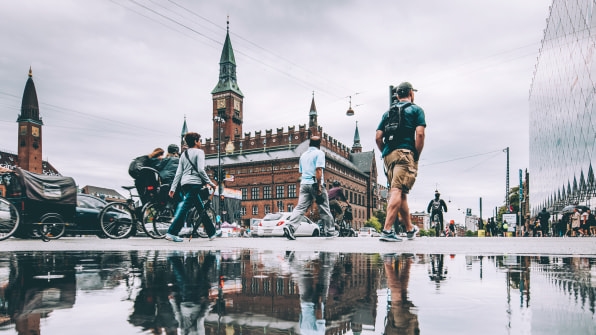How Copenhagen plans to reach carbon-neutral status in just six years
If you miss the metro as you walk up to a stop in central Copenhagen during rush hour, you won’t wait long for the next train: the automated system is designed to run every two minutes. It’s one way for the city to convince residents not to drive a car, and as the metro system expands, one small piece of the city’s ambitious plan to cut emissions.
Six years ago, the city of Copenhagen set the goal to become the first carbon-neutral capital in the world, shrinking energy use as it shifts to renewable energy and produces enough extra green power to offset other remaining emissions. It plans to reach the goal by 2025, while some other cities, including Washington, D.C., are aiming for as late as 2050. So far, it has cut emissions 42%, and city leaders believe it is on track to hit the target. The city is working to become “one of the world’s greenest and most bike-friendly cities,” says Frank Jensen, the city’s lord mayor. “This is the best way forward, because it creates better space, cleaner air, less noise, and a healthier city.”
One piece of the strategy is to improve transportation. In Nordhavn, an industrial neighborhood that is transforming into a sustainable district filled with homes and offices, that means making everything easily accessible. “We created a new vision for transportation: the ‘five-minute city,’ we called it, which means that the city is planned in a way that it only takes you five minutes to walk from your apartment to a kindergarten, to shops, to public amenities,” says Søren Hansen, a project director at Ramboll, an engineering and design company that worked on the strategy for the district. Anyone in the neighborhood will also be a short walk from a new metro line that will open in 2020. “It means that people don’t bother to take their car,” he says. It’s more convenient to bike, walk, or take public transit than go to a central parking garage—buildings don’t have garages of their own—and also drive around looking for parking at the destination.

The mayor also wants to restrict polluting cars from some areas. “I really want to provide new road traffic initiatives, so that we get cleaner air in Copenhagen,” he says. City buses are already shifting from diesel to electricity. In 2017, Jensen proposed banning new diesel cars from entering the city and wanted to begin to implement that restriction this year, though he couldn’t get the needed support from the national government. After recent national elections in which a more liberal party took power, there’s a better chance that it could happen now. “The former government was not ambitious regarding the green agenda, but I really look forward to collaborating with the new social democratic government,” Jensen says. “I think we can push forward the green agenda together, and the new government has set very ambitious goals.” The new government is also now considering making public transit free in the country’s largest cities—including trains that bring commuters into Copenhagen, since those commuters are more likely to drive than people who live in the city center.
The city is already known for its abundance of bicycles: After the oil crisis in the 1970s made the government question car-centric urban planning, it started building better bike infrastructure, and in response, people started to ride more. In 1970, roughly 10% of residents commuted by bike; that number is now 62%. The infrastructure continues to improve, with 12 new bike and pedestrian bridges built over the past decade and an expanding network of cycle highways with tools like repair stations and traffic lights designed to make trips faster.
To shrink the carbon footprint of its electricity use, Copenhagen is shifting to renewable energy. To date, it has installed 62 massive wind turbines with a capacity of 158 megawatts; by 2025, it plans to have an installed capacity of 460 megawatts. Not far from downtown, a huge new power plant turns truckloads of trash into heat and electricity, importing some garbage from as far away as the U.K. (the plant also doubles as a ski slope to bring in extra revenue). Another plant now runs on wood pellets instead of coal to produce heat—though cutting down trees for heat, while technically carbon-neutral, isn’t a long-term solution. The city plans to also use geothermal energy, though it’s only happening at a pilot scale now. Another key part of the plan is making buildings more efficient so they don’t waste energy. That involves both retrofitting old buildings and designing new buildings well; at the new district in Nordhavn, buildings are filled with sensors that researchers are using to collect data and better understand how energy is being used and can be better managed. “The whole district here is a living lab,” says Hansen.
The carbon-neutral goal, as in other cities, only includes emissions from transportation, electricity, heating, and cooling (not, for instance, the footprint of the items that people buy that are made elsewhere and shipped in). But the city is beginning to take steps to reduce emissions from other areas; one new strategy involves serving less meat in city-run kindergartens, hospitals, and other public spaces. It will likely go farther. “I want Copenhagen to be a green leader—also in the future,” Jensen says. “So, we will certainly have very ambitious targets after 2025. Therefore, I am willing to look at all smart solutions, which can make our city greener. Consumption and other emissions could certainly be a part of them.”
He’s hoping that Copenhagen’s work will give other cities an example to follow as they move in the same direction. “Copenhagen’s eco-friendly district heating, our clean harbor, and biking culture could be copied in other cities,” says Jensen. “We insist on green solutions because it pays off. I think that’s a very important message to send to mayors around the world. Copenhagen’s green transformation goes hand in hand with job creation, a growing economy, and a much better quality of life.”
(16)



